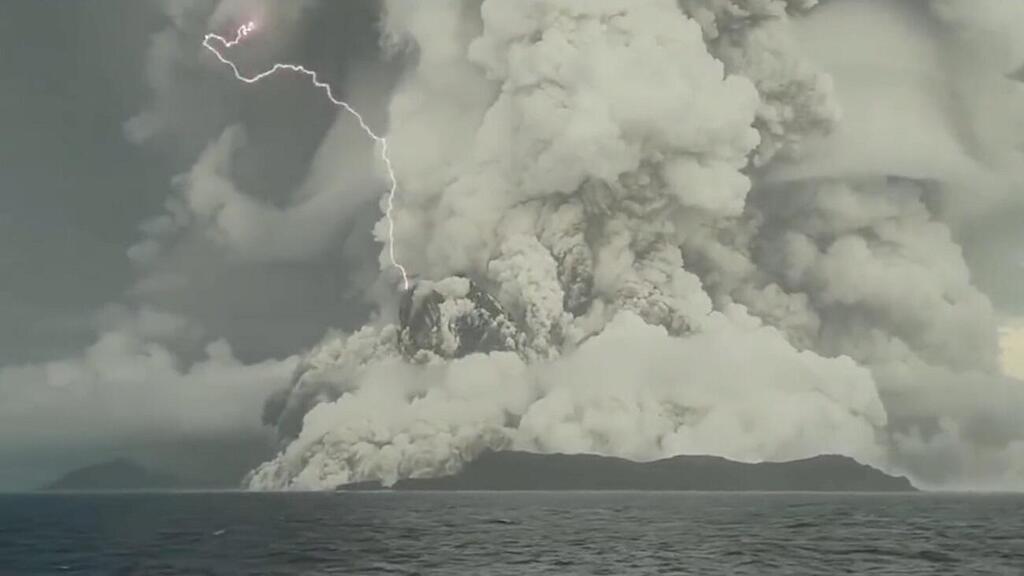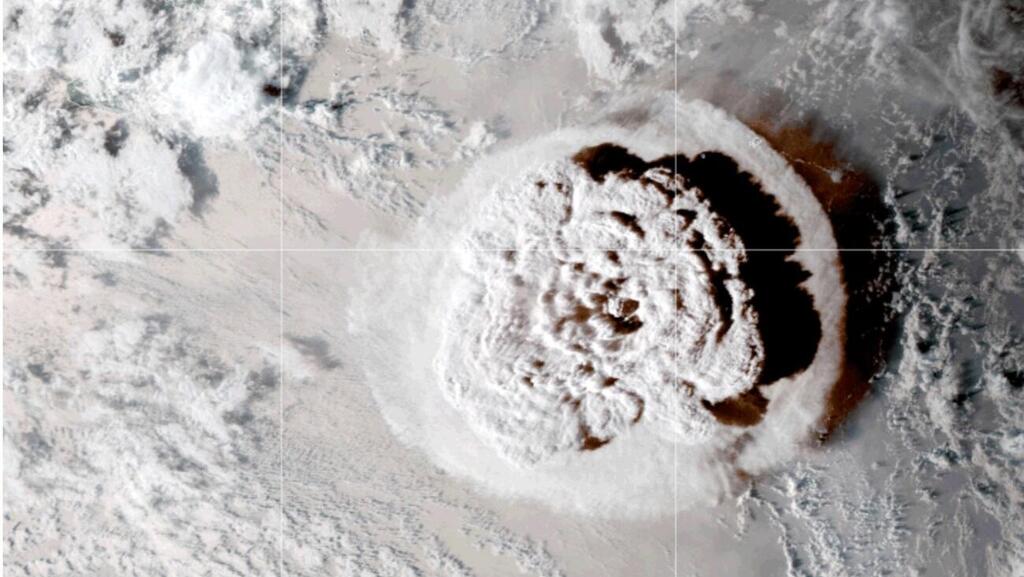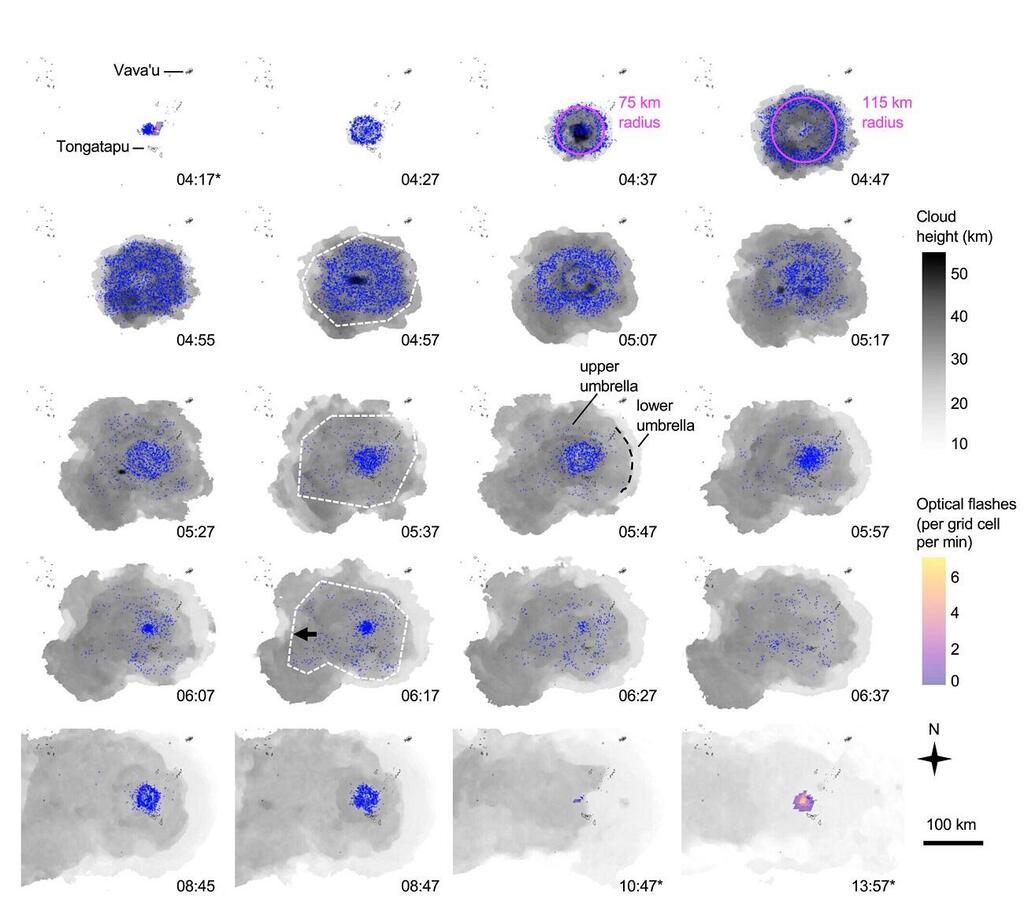Getting your Trinity Audio player ready...
The begining of the Tonga eruption
(Video: Reuters)
A new study found that last year's Hunga Tonga volcanic eruption sparked the most extreme array of electrical activity ever recorded, with a staggering 2,600 lightning flashes per minute, which is hundreds of times more powerful than an atomic bomb.
Read more:
On January 15, 2022, after weeks of rumbling and emitting ash, the underwater caldera near the small Kingdom of Tonga experienced an unprecedented escalation. The Hunga volcano, in the largest volcanic eruption witnessed in over a century, expelled a staggering 2.3 cubic miles of molten rock and evaporated approximately 146 teragrams of water – equivalent to filling 58,000 Olympic swimming pools.
3 View gallery


The Hunga Tonga volcanic eruption expelled a staggering 2.3 cubic miles of molten rock
(Photo: Reuters)
The aftermath also produced a colossal plume, resembling a mushroom cloud, composed of volcanic gases, fragments of magma known as tephra, and evaporated seawater. This towering plume reached an astonishing height of 58 kilometers (36 miles), approximately halfway to the expanse of space.
However, what truly astonished volcanologists was the initial readings that revealed an immense ring of lightning emanating from the epicenter of the eruption, expanding at a staggering speed of approximately 290 kilometers per hour (180 miles per hour). This phenomenon left scientists in awe and sparked a multitude of mysteries, including the destruction of an island caused by the Tonga eruption.
During the eruption, there were nearly 200,000 lightning flashes within the volcanic plume, reaching a peak rate of over 2,600 flashes per minute. This is significantly higher than the previous record of lightning activity, which was observed during a severe thunderstorm over the southern United States in 1999, with a rate of 993 flashes per minute.
"I don’t think any of us really expected ever to see a 280-kilometer-diameter donut of electrical discharges,” says Dr. Alexa Van Eaton, a physical volcanologist with the United States Geological Survey and lead author of a new paper on the Hunga event.
And after combining data from several remote-monitoring systems, she and her team believe they’ve reconstructed how it happened: Plume particles surfing a volcanic “gravity wave” created the perfect storm for record-setting lightning.
3 View gallery


During the eruption, there were nearly 200,000 lightning flashes within the volcanic plume
(Photo: Reuters)
The record-breaking event unfolded due to the immense pressure built up within the subterranean magma chamber of the underwater volcano. Gases were trapped within the chamber, and the fracturing of the rock likely caused a sudden decrease in pressure, allowing the gas to expand and rupture the chamber. The fact that the volcanic cone was located approximately 200 meters (656 feet) below the sea's surface provided an ideal depth for a significant explosion, causing the inflowing seawater to instantaneously turn into steam, accelerating the eruption's rapid spread and intensity.
If the cone had been deeper, the additional pressure from the water would have helped contain the eruption. The molten and hot rock contributed to the rapid vaporization of the sea water, which rose into the plume, ultimately resulting in electrical clashes between volcanic ash, cooled water vapor and hailstones – a collision that provided the perfect conditions for lightning to form.
3 View gallery


Maps of volcanic plume development and lightning in the Hunga-Tonga volcano eruption
(Photo: Geophysical Research Letters (2023). DOI: 10.1029/2022GL102341)
The researchers identified four distinct stages of eruptive volcanic activity, characterized by the height of the plume and the frequency of lightning strikes as they grew and waned. The insights gained from the correlation between lightning intensity and eruptive activity provide better monitoring and prediction of aviation hazards during major volcanic eruptions, including the development and movement of volcanic ash clouds. Obtaining reliable early detection of volcanic plumes, especially for remote submarine volcanoes, presents a significant challenge.
The integration of all available long-range observations, including lightning, improves early detection to keep aircraft and people out of harm's way.
"Not only the intensity of the lightning grabs our attention, but also the concentric rings of the lightning, centered on the volcano, which expanded and contracted over time. The size of the lightning rings was something we had never seen before, so there is no comparison to any other meteorological event," said Van Eaton. In fact, the volcanic plume injected such a significant mass into the upper atmosphere that it formed an umbrella-shaped cloud, similar to what happens when a river delta discharges into a lake.
Van Eaton and her fellow researchers noted that the lightning "surfaced" on the same waves and moved outward as rings with a width of 250 kilometers. If that isn't fascinating enough, this eruption belongs to a volcanic style known as a phreatoplinian eruption, also called a phreatomagmatic explosion, ultra-volcanic eruption, or phreatic eruption.
It occurs when a magma chamber interacts with deep-sea or shallow water, causing the extreme temperature of the magma to almost instantaneously vaporize the water into steam. As a result, a violent explosion of steam, water, ash, rock and volcanic bombs occurs. In the past, this eruption style was only known from geological records and had never been observed with modern equipment, making the Tonga eruption a milestone in this regard.
"It was like uncovering a dinosaur and seeing it walk on four legs – a breath-taking event," Van Eaton concluded.




